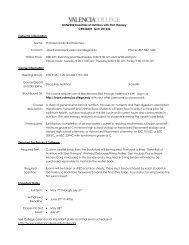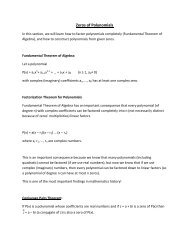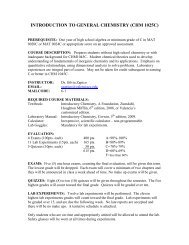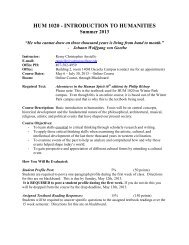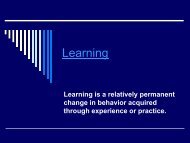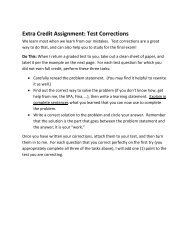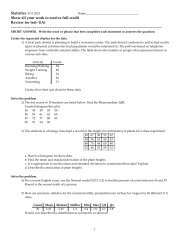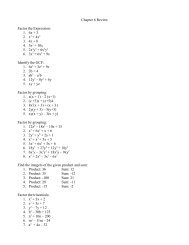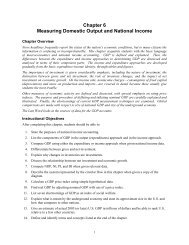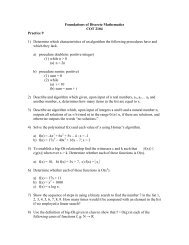ECO 2013: Macroeconomics Valencia Community College
ECO 2013: Macroeconomics Valencia Community College
ECO 2013: Macroeconomics Valencia Community College
Create successful ePaper yourself
Turn your PDF publications into a flip-book with our unique Google optimized e-Paper software.
<strong>ECO</strong> <strong>2013</strong>: <strong>Macroeconomics</strong><strong>Valencia</strong> <strong>Community</strong> <strong>College</strong>Final Exam Fall 20081. Fiscal policy is carried out primarily by:A. the Federal government.B. state and local governments working together.C. state governments alone.D. local governments alone.2. If the MPS in an economy is 0.1, government could shift the aggregate demand curverightward by $40 billion by:A. increasing government spending by $4 billion.B. increasing government spending by $40 billion.C. decreasing taxes by $4 billion.D. increasing taxes by $4 billion.3. If the MPC in an economy is 0.8, government could shift the aggregate demand curverightward by $100 billion by:A. increasing government spending by $25 billion.B. increasing government spending by $80 billion.C. decreasing taxes by $25 billion.D. decreasing taxes by $100 billion.4. If the MPS in an economy is 0.4, government could shift the aggregate demand curve leftwardby $50 billion by:A. reducing government expenditures by $125 billion.B. reducing government expenditures by $20 billion.C. increasing taxes by $50 billion.D. increasing taxes by $250 billion.5. In a certain year the aggregate amount demanded at the existing price level consists of $100billion of consumption, $40 billion of investment, $10 billion of net exports, and $20 billion ofgovernment purchases. Full-employment GDP is $120 billion. To obtain price level stabilityunder these conditions the government should:A. increase tax rates and/or reduce government spending.B. discourage personal saving by reducing the interest rate on government bonds.C. increase government expenditures.D. encourage private investment by reducing corporate income taxes.6. An appropriate fiscal policy for severe demand-pull inflation is:A. an increase in government spending.B. depreciation of the dollar.C. a reduction in interest rates.D. a tax rate increase.1
7. Suppose that in an economy with a MPC of 0.5 the government wanted to shift the aggregatedemand curve rightward by $80 billion at each price level to expand real GDP. It could:A. reduce taxes by $160 billion.B. increase government spending by $80 billion.C. reduce taxes by $40 billion.D. increase government spending by $40 billion.8. Suppose that in an economy with a MPC of 0.8 the government wanted to shift the aggregatedemand curve leftward by $40 billion at each price level to remedy demand-pull inflation. Itcould:A. increase taxes by $10 billion.B. reduce government spending by $40 billion.C. reduce government spending by $5 billion.D. increase taxes by $20 billion.9. Which of the following represents the most contractionary fiscal policy?A. a $30 billion tax cutB. a $30 billion increase in government spendingC. a $30 billion tax increaseD. a $30 billion decrease in government spending10. A tax reduction of a specific amount will be more expansionary, the:A. smaller is the economy's MPC.B. larger is the economy's MPC.C. smaller is the economy's multiplier.D. less the economy's built-in stability.2
11. Refer to the above diagram, in which Q f is the full-employment output. A contractionaryfiscal policy would be most appropriate if the economy's present aggregate demand curve wereat:A. AD 0 .B. AD 1 .C. AD 2 .D. AD 3 .12. Refer to the above diagram, in which Q f is the full-employment output. An expansionaryfiscal policy would be most appropriate if the economy's present aggregate demand curve wereat:A. AD 0 .B. AD 1 .C. AD 2 .D. AD 3 .13. Refer to the above diagram, in which Q f is the full-employment output. If the economy'spresent aggregate demand curve is AD 2 :A. the most appropriate fiscal policy is an increase of government expenditures or a reduction oftaxes.B. the most appropriate fiscal policy is a reduction of government expenditures or an increase oftaxes.C. government should undertake neither an expansionary nor a contractionary fiscal policy.D. the economy is achieving its maximum possible output.14. Refer to the above diagram, in which Q f is the full-employment output. If the economy'scurrent aggregate demand curve is AD 0 , it is experiencing:A. a positive GDP gap.B. a negative GDP gap.C. inflation.D. an adverse supply shock.15. Refer to the above diagram, in which Q f is the full-employment output. If the economy'scurrent aggregate demand curve is AD 3 , it is experiencing:A. a positive GDP gap.B. a negative GDP gap.C. a recession.D. cost-push inflation.16. Refer to the above diagram, in which Q f is the full-employment output. If the economy'scurrent aggregate demand curve is AD 0 , it would be appropriate for the government to:A. reduce government expenditures and taxes by equal-size amounts.B. reduce government expenditures or increase taxes.C. increase government expenditures or reduce taxes.D. reduce unemployment compensation benefits.3
17. Refer to the above diagram in which T is tax revenues and G is government expenditures.All figures are in billions. If GDP is $400:A. there will be a budget deficit.B. there will be a budget surplus.C. the budget will be balanced.D. the macroeconomy will be in equilibrium.18. In the above diagram it is assumed that investment, net exports, and government purchases:A. are leakages from the circular flow.B. are independent of the level of GDP.C. vary inversely with GDP.D. vary directly with GDP.19. Refer to the above diagram. The equilibrium level of GDP is:A. Y 5 .B. Y 4 .C. Y 3 .D. Y 2 .20. Refer to the above diagram. If the full-employment GDP is Y 5 , government should:A. incur neither a deficit nor a surplus.B. cut taxes and government spending by equal amounts.C. reduce taxes and increase government spending.D. increase taxes and reduce government spending.4
21. A $70 price tag on a sweater in a department store window is an example of moneyfunctioning as a:A. unit of account.B. standard of deferred payments.C. store of value.D. medium of exchange.22. When economists say that money serves as a store of value, they mean that it is:A. a way to keep wealth in a readily spendable form for future use.B. a means of payment.C. a monetary unit for measuring and comparing the relative values of goods.D. declared as legal tender by the government.23. Currency in circulation is part of:A. M1 only.B. M2 only.C. MZM only.D. M1, M2, and MZM.24. A $20 bill is a:A. gold certificate.B. Treasury note.C. Treasury bill.D. Federal Reserve Note.25. Coins held in commercial banks are:A. included in M1, but not in M2.B. included both in M1 and in M2.C. included in M2, but not in M1.D. not part of the nation's money supply.26. Assuming no other changes, if checkable deposits decrease by $40 billion and balances inmoney market mutual funds increase by $40 billion, the:A. M1 money supply will decline and M2 money supply will remain unchanged.B. M1 and M2 money supplies will not change.C. M2 and MZM money supplies will increase.D. M1, M2, and MZM money supplies will decline.5
27. Refer to the above information. Money supply M1 for this economy is:A. $60.B. $70.C. $130.D. $140.28. Refer to the above information. Money supply M2 for this economy is:A. $480.B. $130.C. $490.D. $630.29. Refer to the above information. Money supply MZM for this economy is:A. $480.B. $630.C. $490.D. $530.Answer the next question(s) on the basis of the following list of assets:1. Large ($100,000 and over) time deposits2. Noncheckable savings deposits3. Currency (coins and paper money)4. Small (under $100,000) time deposits5. Stock certificates6. Checkable deposits7. Money market deposit accounts8. Money market mutual fund balances held by individuals9. Money market mutual fund balances held by businesses30. Refer to the above list. The M1 definition of money comprises item(s):A. 6 only.B. 3, 4, and 6.C. 3 and 6.D. 2, 3, and 6.31. Refer to the above list. The M2 definition of money comprises:A. items 1, 2, 3, and 6.B. items 3, 4, 5, and 6.C. items 2, 3, 4, 6, 7, and 8.D. items 1, 2, 3, and 4.32. Refer to the above list. The MZM definition of money comprises:A. items 2, 3, 6, 7, 8, and 9.B. items 2, 3, 4, 6, 7, and 8.C. items 1, 3, 6, 7, and 8.D. all of the nine items listed.6
33. Refer to the above list. Which of the following is not included in any of the three officialdefinitions of money (M1, M2, MZM)?A. item 2B. item 5C. item 4D. items 1 and 5Answer the next question(s) on the basis of the following table:34. Refer to the above table. The value of the dollar in year 2 is:A. $1.25.B. $1.33.C. $.80.D. $1.00.35. Refer to the above table. The value of the dollar in year 3 is:A. $1.00.B. $1.25.C. $.80.D. $1.10.36. Refer to the above table. The value of the dollar in year 4 is:A. $1.25.B. $.33.C. $.50.D. $2.00.37. The Federal Open Market Committee (FOMC) is made up of:A. the chair of the Board of Governors along with the 12 presidents of the Federal ReserveBanks.B. the seven members of the Board of Governors along with the president of the New YorkFederal Reserve Bank.C. the seven members of the Board of Governors of the Federal Reserve System along with thethree members of the Council of Economic Advisers.D. the seven member of the Board of Governors of the Federal Reserve System along with thepresident of the New York Federal Reserve Bank and four other Federal Reserve Bankspresidents on a rotating basis.7
38. How many commercial banks are now operating in the United States?A. about 140,000B. about 7,600C. about 11,400D. about 6,30039. Which of the following is not part of the M2 money supply?A. currency in circulation.B. credit card balances.C. small time deposits of less than $100,000.D. checkable deposits.40. A bank that has assets of $85 billion and a net worth of $10 billion must have:A. liabilities of $75 billion.B. excess reserves of $10 billion.C. liabilities of $10 billion.D. excess reserves of $75 billion.41. The ABC Commercial Bank has $5,000 in excess reserves and the reserve ratio is 30percent. The bank must have:A. $90,000 in outstanding loans and $35,000 in reserves.B. $90,000 in checkable deposit liabilities and $32,000 in reserves.C. $20,000 in checkable deposit liabilities and $10,000 in reserves.D. $90,000 in checkable deposit liabilities and $35,000 in reserves.42. Suppose a commercial bank has checkable deposits of $100,000 and the legal reserve ratio is10 percent. If the bank's required and excess reserves are equal, then its actual reserves:A. are $30,000.B. are $10,000.C. are $20,000.D. cannot be determined from the given information.Answer the next question(s) on the basis of the following table for a commercial bank or thrift:8
43. Refer to row 1 in the above table. The number appropriate for space W is:A. 4.B. 6.C. 10.D. 12.44. Refer to row 2 in the above table. The number appropriate for space X is:A. $20,000.B. $60,000.C. $200,000.D. $100,000.45. Refer to row 3 in the above table. The number appropriate for space Y is:A. $24,000.B. $32,000.C. $48,000.D. $96,000.46. Refer to row 4 in the above table. The number appropriate for space Z is:A. $10,000.B. $70,000.C. $48,000.D. zero.47. Assume Company X deposits $100,000 in cash in commercial Bank A. If no excess reservesexist at the time this deposit is made and the reserve ratio is 20 percent, Bank A can increase themoney supply by a maximum of:A. $50,000.B. $180,000.C. $80,000.D. $500,000.48. Assume that Smith deposits $600 in currency into her checking account in the XYZ Bank.Later that same day Jones negotiates a loan for $1,200 at the same bank. In what direction and bywhat amount has the supply of money changed?A. decreased by $600B. increased by $1,800C. increased by $600D. increased by $1,20049. The legal reserve ratio applies to checkable deposits at:A. national banks.B. credit unions.C. savings and loans.D. institutions of all of these types.9
50. If m equals the maximum number of new dollars that can be created for a single dollar ofexcess reserves and R equals the required reserve ratio, then for the banking system:A. m = R 1.B. R = m/1.C. R = m 1.D. m = 1/R.51. Suppose a commercial banking system has $100,000 of outstanding checkable deposits andactual reserves of $35,000. If the reserve ratio is 20 percent, the banking system can expand thesupply of money by the maximum amount of:A. $122,000.B. $175,000.C. $300,000.D. $75,000.Answer the next question(s) on the basis of the following consolidated balance sheet for thecommercial banking system. Assume the required reserve ratio is 10 percent. All figures are inbillions.52. Refer to the above data. The commercial banking system has excess reserves of:A. $0 billion.B. $30 billion.C. $60 billion.D. $70 billion.53. Refer to the above data. After a deposit of $10 billion of new currency into a checkingaccount in the banking system, excess reserves will increase by:A. $0 billion.B. $7 billion.C. $9 billion.D. $10 billion.54. Refer to the above data. After the deposit, the maximum amount by which this commercialbanking system can expand the supply of money by lending is:A. $9 billion.B. $45 billion.C. $36 billion.D. $90 billion.10
Answer the next question(s) on the basis of the following information about a banking system:new currency deposited in the system = $40 billion; legal reserve ratio = 0.20; excess reservesprior to the currency deposit = $0.55. Refer to the above information. The $40 billion deposit of currency into checking accountswill initially create:A. $8 billion of new checkable deposits.B. $10 billion of new checkable deposits.C. $40 billion of new checkable deposits.D. $160 billion of new checkable deposits.56. Refer to the above information. The $40 billion deposit of currency into checking accountswill create excess reserves of:A. $20 billion.B. $32 billion.C. $40 billion.D. $0.57. Refer to the above information. The banking system will be able to expand the money supplythrough loans by:A. $160 billion.B. $200 billion.C. $40 billion.D. $128 billion.58. Refer to the above information. The $40 billion deposit of new currency will support totalcheckable deposits of:A. $160 billion.B. $200 billion.C. $40 billion.D. $128 billion.59. Money is destroyed when:A. loans are made.B. checks written on one bank are deposited in another bank.C. loans are repaid.D. the net worth of the banking system declines.60. The bank panics of 1930–1933:A. resulted in the passage of the Smoot-Hawley Act.B. boosted the nation's money supply, causing inflation.C. directly resulted in the Federal insured deposit program.D. caused a significant outflow of gold from the United States.11



